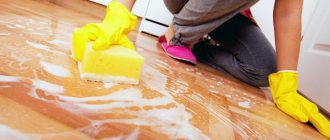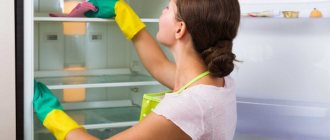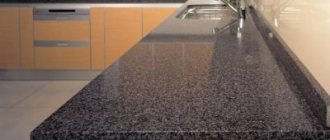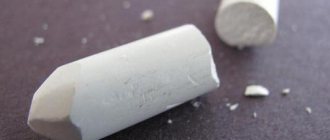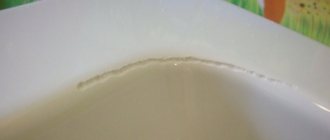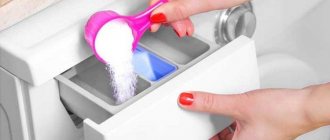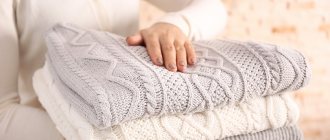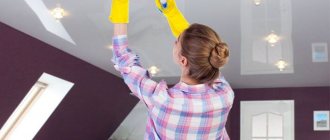Wet cleaning is an integral part of everyday life. Allows you to eliminate dust and pollution from the surrounding area. When carrying out work, water and disinfectant solutions are used. First, moisture-resistant surfaces are cleaned and carpets and upholstered furniture are treated. Next, they wash and disinfect the bathrooms and move on to cleaning the floors.
What it is?
Wet cleaning is a set of actions aimed at humidifying the air, removing dust and other contaminants from various surfaces. A prerequisite for this is the use of liquid.
It is performed manually and using various tools and equipment:
- rags,
- buckets,
- basins,
- washing vacuum cleaners,
- mop,
- washcloths and more.
Without such processing, it is impossible to imagine the functioning of any institution with a large crowd of people: preschool educational institutions, schools, hospitals, shops and more. It is mandatory for implementation both inside public facilities and in ordinary apartments.
Secrets of cleaning masters
An apron with large pockets will help you keep your cleaning equipment with you.
Use an apron with several large pockets for tools and a basket for detergents, then everything will be at hand. First, remove things that are lying around out of place, otherwise they will constantly bother you. Do not put unnecessary items on the far shelf; take them to the trash container.
To avoid rushing from corner to corner and missing anything, clean from top to bottom. First of all, you need to wipe the lampshades, cornices and tops of cabinets. Go lower, clean the bookshelves, sideboards, then tables, window sills, bedside tables. Lastly, tackle the floor. There is one exception to this rule. If heavily soiled parquet flooring requires sweeping, do so at the beginning of the job. Otherwise, dust from the floor will land on already wiped chairs and bedside tables.
It is convenient to clean dirty window glass and mirrors with wipes for wiping monitors. Wool and hair stick well to rubber gloves. Run your hand over the surface where your pet often lies, and then rinse off the lint under running water. Don't wash every leaf of an indoor flower by hand, put all the plants in a bath and spray them with a shower. Cover the tops of cabinets with scrap paper or old newspapers. The next time you clean, use a spray bottle to dampen the dust, remove the soiled sheets and replace with fresh ones. When the whole complex of work is completed, ventilate the room well.
For professional wet cleaning, craftsmen use new technologies. Instead of buckets with a mop, mops are purchased; they are changed after each washed area.
When working in offices and institutions over a large area, the following technical means are used:
- washing vacuum cleaner,
- steam generator,
- scrubber dryer,
- cleaning cart with 2 buckets and compartments for small items.
The experience of cleaning masters will be especially useful if you live in a large cottage where you have to clean a large area. Many secrets can be used in small apartments.
Kinds
Wet cleaning can be of several types:
Using only water to remove dust from surfaces.- Using disinfectants aimed at destroying microbial flora.
- Daily, when surfaces no taller than human height are treated.
- General, with the treatment of all surfaces in the room, including washing windows, ceilings and floors.
- After the renovation is completed.
Also, wet cleaning can be professional and household. In the first case, we are talking about strict adherence to instructions when performing cleaning activities.
The work is carried out by specially trained personnel who receive payment for their work. Household processing is carried out on our own, in private houses and apartments.
“Household Service”: when there is nothing to worry about cleanliness
Success is the result of many years of hard work, labor and a close-knit team. We understand how important cleanliness is for making serious decisions, so our services mean excellent quality, snow-white and shining cleanliness of every centimeter of your room. After cleaning, you will forget about the need to regularly ventilate the room: the room is saturated with a fresh aroma and pleasant fresh smells of cleanliness and order.
Our cleaning company employees take calls by phone. From the beginning of the order to its high-quality and fast execution, you will be surrounded by high professionalism and understanding. Call Household Service, and there will truly never be any problems in your home!
Why is regular cleaning of premises necessary?
It is impossible to underestimate the importance of wet cleaning indoors. It should be carried out regularly for the following reasons:
- Cleaning the air from dust. Its accumulation is a direct path to the development of diseases of the respiratory system, allergies and more. Dust may contain infectious agents: viruses, bacteria and fungi.
- Destruction of dust mites and their metabolic products. These are microscopic organisms that are invisible to the human eye, but can cause allergies.
- Removing stains and other contaminants from the surface.
- Disinfection of surfaces.
- Air humidification.
Wet cleaning is necessary for people suffering from allergies or viral infections. Dust with dust mites and their metabolic products is a powerful irritant that can worsen the quality of life and lead to the progression of the disease.
Why is wet cleaning necessary?
Often people neglect wet cleaning. The reason for this may be lack of time, ignorance or inability to do it, and simple laziness. Dirt, dust, unwashed floors, clutter in the room, leftover food in the kitchen, garbage left in the bin, unsanitary conditions... all this creates a favorable environment for pathogenic bacteria and microorganisms, pests . Coexistence with them causes a person to:
- Decreased immunity
- Allergies
- Intestinal diseases
- Lung diseases
- Skin infections
- Parasite infestation
Pests such as cockroaches, woodlice, bedbugs, silverfish, lice, fleas, weevils, ants, etc. feel comfortable in dirty homes. Which can be carriers of much more serious diseases and infections.
How often should I do it?
The frequency of wet cleaning depends on the characteristics of the object. If we are talking about a medical institution or preschool educational institution, then it is performed there several times a day. For each social facility, there are regulations and Sanitary Regulations developed at the legislative level that must be observed.
The frequency of treatment in an apartment or house depends on a number of factors, including:
- time of year - in summer and winter the air in the room is drier, which means there is more dust in it;
- number of residents;
- the presence of carpet and other fabric coverings;
- location of the apartment - if it is on the ground floor, you will have to clean up more often.
To make the work easier, it is recommended to use special equipment , for example:
- washing vacuum cleaners,
- steam cleaners,
- ionizers and air humidifiers.
Their use reduces the amount of dust in the room, which allows you to spend less time putting things in order. Read how to clean with a steam cleaner here.
Preparing for cleaning
The amount of time spent on cleaning will depend on the preparatory work. Focusing on activities will ensure that all surfaces that need to be cleaned are covered.
Subsequence:
- All items to be cleaned must be marked.
- Specify the surfaces to be treated that require daily wet cleaning.
- Prepare all cleaning supplies, mops and buckets. Before carrying out wet cleaning, you should do dry cleaning with a rag or brush.
What is included in daily wet cleaning:
- upper cabinets;
- shelves with books;
- sconces and chandeliers;
- picture frames;
- headboards;
- window and door frames;
- Appliances;
- decor
If there are a lot of small parts, then experts recommend using a long-haired brush. Floor lighting, if present, also needs to be cleaned.
How is it different from general and dry?
General cleaning is carried out no more than once a month . In addition to accessible surfaces, windows, doors, lighting fixtures, radiators, ceilings are washed, and furniture is moved away. All hard-to-reach places are being worked on.
If during wet cleaning they wash the floors, remove dust and throw away garbage, then the range of work during general cleaning is much wider. At the same time, general cleaning is impossible without wet cleaning. These are two inextricably linked concepts.
Dry cleaning involves avoiding the use of liquid detergents and water. It is used when getting wet surfaces is detrimental, or they are only slightly contaminated.
Dry cleaning removes visible debris and sweeps away cobwebs from furniture and curtains . Dust is collected with a vacuum cleaner or special brushes. Carpets and rugs are cleaned with improvised means. It is carried out 1-2 times a week.
Advantages of a cleaning company
By inviting a cleaning service, you can be sure that every spot on the floor or any other surface will be eliminated. And most importantly - in a short time, with minimal labor costs, with high quality service at all stages. From calling the order, to removing dirt and polishing the floors to shine, the customer has exclusively professional and well-trained workers at his disposal. Thanks to the professionals from the cleaning company, cleaning any buildings with varying levels of complexity will not take much time and effort. The advantage of turning to specialized companies is:
- Qualified specialists
- Fast and high-quality cleaning
- Safe use of only the highest quality cleaning products and detergents
- The ability to eliminate pollution that formed several years ago
- Confidence that all types of contaminants can be easily removed with high-quality tools
- After general cleaning, you can forget about fine dust and difficult floor cleaning work: detergents create a safe and invisible protective film
- Opportunity to save on the purchase of new flooring and expensive coverings (laminate, marble)
- Company cleaning may (optional) include additional dry cleaning
Successful modern companies have no time to monitor cleanliness. But now this is not necessary! After all, you can always order one that really knows what “perfect cleanliness” is.
How is it carried out?
The main purpose of this treatment is to rid the room of dust and dirt. The specifics of its implementation depend on which particular object is being brought into order.
Basic actions:
Removing dust from lighting fixtures.- Washing furniture.
- Washing or steam cleaning curtains or blinds.
- Cleaning radiators, windows and doors.
- Washing the floor, cleaning the floor covering.
- Cleaning of bathrooms with disinfection of surfaces.
Not all items are present on the daily to-do list. Surfaces are treated as they become dirty. If cleaning is carried out in an apartment, it is recommended to adhere to the following algorithm:
- they begin to put things in order from the farthest room - they always move in the direction from the window to the door;
- in the kitchen, clear all surfaces, wash dishes, then wipe tables, cabinets and window sills with a damp cloth, treat appliances and hanging shelves;
- The bathtub and toilet are washed using special products that have a disinfectant effect.
You need to wash bed linen and clean carpeting regularly.
In order for as little dust as possible to accumulate in the room, you need to get rid of things that are “accumulators” of dust, for example, soft toys, old books, unnecessary clothes. There are rules for wet cleaning that should be followed to increase productivity:
- You need to move around the house in such a way as not to repeatedly enter places that have already been cleaned.
- If dust and dirt are noticeable on the surfaces, you need to sweep it away and only then proceed with treatment with wet rags.
- To ensure that things accumulate less dust, they need to be stored in special cases.
- When cleaning, you should not forget about washing indoor plants, on which dust also settles.
The main principle of any wet cleaning is washing from top to bottom. This means washing cabinets, chandeliers, curtains first, then countertops, mirrors and doors. Only after this can you proceed to washing the floor.
What to do after repair?
Before you begin wet cleaning after renovation, you must remove all construction debris, both large and small.
When the surfaces are clean, collect dust . To do this, it is recommended to use a vacuum cleaner. You need to walk not only on the floor, but also on the walls.
When the bulk of the dust has been collected, begin wet cleaning. The water needs to be changed as often as possible. This is the only way to prevent divorces from occurring.
Before processing sockets and switches, the room must be de-energized. Specialized compounds are used for different surfaces.
For example, those products that are used for cleaning floors are not suitable for treating ceramic tiles. If the scale of work is impressive, it is better to seek the help of professionals .
Removing dust
First, we wipe the surfaces from dust. We start from top to bottom. That is, we stand on a stool or stand and use a damp cloth to wipe off the dust from the chandelier, from cabinets, cupboards, and shelves. Rinse the cloth as it gets dirty. To avoid constantly going to the sink, hold a dust cloth in one hand and a bucket of clean water in the other. The water also needs to be changed periodically.
After the “high” surfaces we go down. We wipe down tables, chairs, cabinets, that is, all the furniture. Pay special attention to window sills. Even in winter, a lot of dust from the street settles on them. We carefully go over household appliances with a cloth: computer (except the screen), TV, game consoles, etc.
Attention! Before wiping any electrical appliance with a damp cloth, it is IMPORTANT that it is unplugged from the outlet!
It is advisable to immediately wipe everything with a dry cloth. To prevent “fresh” dust from sticking to the wet surface.
Helpful information
Tips to help make wet cleaning easier:
- It is better to use microfiber or cotton rags for surface treatment. They do not leave behind streaks and absorb the maximum amount of dust. At the same time, it is necessary to monitor their cleanliness. After each treatment, the rags are dried so that an unpleasant odor does not begin to emanate from them.
- Do not wait until the dust layer becomes thick. It needs to be removed as it appears. This will save time when carrying out wet cleaning.
- When washing the floor, it is recommended to add a few drops of essential oil to the bucket, which will make the air more fragrant.
- When treating furniture, you can use an antistatic agent, which will prevent dust from settling on surfaces.
- It is recommended to wash carpets in the warm season so that they have time to dry completely. Wet carpet will become a source of growth for mold and germs.
- Modern equipment will help make cleaning easier. Even a new mop with an automatic spin and a telescopic handle will save time on cleaning.
- It is recommended to wash the hallway last.
Sequence of rooms
Everyone has different apartments, different layouts, different numbers of rooms and floors. It is necessary to develop your own sequence of actions . There are a number of general “rules”. It is better to tidy up from the farthest room, moving towards the corridor, then to the bathroom.
Rooms
In addition to dusting and washing the floor, the rooms usually contain upholstered furniture and carpets on the floor. Furniture can be gently wiped with a damp cloth over the entire surface. Use a vacuum cleaner with a special attachment to get into the joints, folds, and crevices of the furniture. There are special cleaners for carpets . Use them according to the instructions on the packaging.
Kitchen
Greasy or difficult to remove stains often form on work surfaces here. This is especially true for the stove. Use kitchen cleaner. It contains components to dissolve such contaminants. Get a separate sponge for the stove. On one side there is a more rigid surface. It is difficult to wipe off such stains with a regular rag.
The kitchen sink needs careful cleaning and disinfection. A lot of bacteria accumulate on its surface, which feed on food debris from dirty dishes. A disinfectant is suitable for cleaning it. Usually these come with a label on the label “for the kitchen”, or “for sinks”, or “for the kitchen and bathroom”.
Hallway
Particular attention should be paid to the place where people take off their shoes and store their shoes. Along with shoes, street dirt, earth, and sand are brought into the house. They contain a lot of bacteria. Shoe mats should be shaken off or thrown outside.
Some people pat mats while standing on the balcony. Dirt from it can fall onto a neighboring balcony or window sill. Be polite to your neighbors! Don't do this!
Before washing the hallway, it is better to clean all the shoes in the hallway. Remove it so it doesn't interfere
Bathroom
First, it is recommended to clean the tiles on the wall adjacent to the bathtub. A plumbing or tile cleaner (if available) is suitable for this purpose.
Use bath cleaner and a sponge to clean the surface of the bathtub. Bacteria, fat from the human body, residues of detergents, dust, and dirt also accumulate on it . Don't forget to use a disinfectant to thoroughly clean the taps. We wash our hands with soap regularly. But at the same time, we often forget that we then touch the tap with these clean hands.
There is usually a mirror hanging in the bathroom. Mirrors are washed with cleaning products whose label says “For cleaning glass” or “For mirrors” . Spray the product onto the mirror and wipe the surface with a dry, clean cloth.
Toilet
Perhaps the most important room in terms of thorough cleaning. Here, all surfaces (including the floor) must be washed with a disinfectant. There are disinfectant cleaning products for the toilet. You need to work with them while wearing gloves, because... they contain strong chemicals .
You can prepare such a solution yourself. A little disinfectant cleaner is dissolved in a small amount of water. If necessary, this solution can be made several times.
Apply the cleaner around the inside of the toilet around its circumference. Try to get under the rim as much as possible. The spout on a bottle of toilet cleaner is usually designed in such a way that it is convenient for you to do it. The space under the rim is a difficult place to reach. Bacteria accumulate there. Use a toilet brush to clean the inside. Try to crawl under the rim . Do not rush to wash off the remaining product. Leave everything as is until the end of cleaning. So that the flowing chemicals slide down on their own. Rinse it off at the very end, when you have already completed the cleaning, washed the rags, put away the equipment, and washed your hands.
Leave the brush in the toilet. While it is lying there, wash the stand in which it was stored with a disinfectant solution.
The outside of the toilet itself also needs to be wiped with a disinfectant solution or wipes with alcohol . They can also be used to treat the toilet seat.
Wipe the ventilation grilles in the bathroom (in the kitchen, by the way, too)
After cleaning, rinse the rags thoroughly in warm running water and soap. After this, hang it on the radiator or on the balcony to dry. Don't dry them for too long. So that dust does not settle on them. Periodically replace the rags with new ones.
Office cleaning in Moscow
Are you tired of learning Uzbek or Tajik? Explain that cleanliness in the office is not your whim, but the responsibility of the staff who receive a salary for it? Tired of spending money on expensive equipment, making sure the cleaning lady doesn’t get sick or accidentally take away half of your office? We will be happy to solve your problems - our employees will clean the office at your request at a time convenient for you and at the best price per m2 in Moscow - they will not get sick, you will not have to pay taxes for them and they are afraid of the Federal Migration Service or the fact that one fine morning you you will find an empty room without furniture, equipment and documents with a safe.
Estimated prices for office cleaning:
1 day a week | |||||
| Area, m2 | up to 60 | 70-90 | 90-100 | 100-120 | from 120 |
| Cost, rub* | 8500 | 11000 | 15000 | 20000 | Great Dane |
2 days a week | |||||
| Area, m2 | up to 60 | 70-90 | 90-100 | 100-120 | from 120 |
| Cost, rub* | 10500 | 14000 | 16000 | 22000 | Great Dane |
3 days a week | |||||
| Area, m2 | up to 60 | 70-90 | 90-100 | 100-120 | from 120 |
| Cost, rub* | 12500 | 16000 | 18000 | 24000 | Great Dane |
4 days a week | |||||
| Area, m2 | up to 60 | 70-90 | 90-100 | 100-120 | from 120 |
| Cost, rub* | 13500 | 17000 | 19000 | 25000 | Great Dane |
